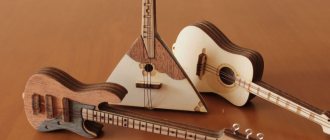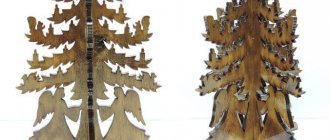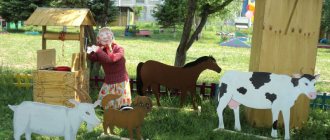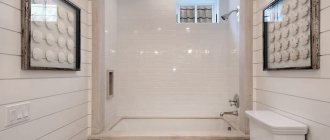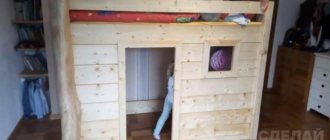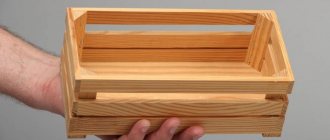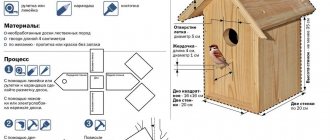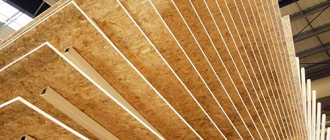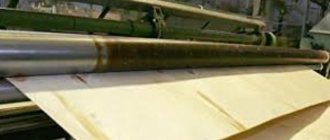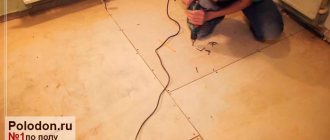Material characteristics
Wood plywood is made by gluing very thin sheets of wood (veneer) together. This material is easily amenable to various processing, both thermal and mechanical; it can be painted with paint and varnishes of any kind. It is worth noting that plywood harmonizes very well with any other material, which designers successfully use. Veneer, as plywood is otherwise popularly called, has the following characteristics:
- It has a layered woody structure.
- To produce the material, veneer sheets with a thickness of 2-4 mm are used; as a result, the thickness of the plywood sheet can reach from 4 to 32 mm.
- The quality of construction plywood depends on the type of veneer, which can be natural or tinted. Natural veneer is more durable, stronger, environmentally friendly and safer.
- It has very good thermal conductivity and environmental friendliness, in which it is superior to chipboard, fiberboard and MDF.
- The ratio of performance indicators and production costs of plywood is higher than that of metal or plastic.
- It is quite light in weight and easily tolerates temperature changes.
Plywood classification
Depending on the characteristics, plywood of any hardness differs in service life, appearance, types and grades:
- By purpose it happens:
- construction plywood – used in the construction of houses as floors and partitions;
- industrial plywood – for ship, carriage and automobile construction;
- packaging plywood – used for packaging large items, furniture, electronic equipment and more;
- furniture plywood - home and office furniture is made from it;
- structural plywood - used to create various structures, decorations and displays.
- Depending on the number of layers of veneer, plywood is:
- three-layer;
- five-layer;
- multilayer.
To ensure that the veneer sheets are arranged symmetrically with respect to the central sheet, they are taken in an odd number. In the case when the number of veneers is even, it is necessary to glue the two central sheets perpendicular to the two outer ones, this will increase strength and resistance to deformation. The thicker the plywood sheet, the more expensive it is, accordingly.
- There are three types of plywood:
- moisture-resistant plywood (FC) – moisture resistance is relative, since even in rooms with not very high humidity it can suffer. Actively used in the manufacture of furniture and packaging material;
- increased moisture resistance (FSF) - due to its good resistance to moisture, it is used not only for interior work, but also for exterior work. This type of plywood bends well, can easily be processed in other ways - drilling, sanding, planing, sawing, and can be painted and varnished well. Many builders note that working with this material is a great pleasure;
- increased moisture resistance melamine (FKM) - melamine or bakelite glue is used in production. This type of plywood has a popular name - marine plywood. It is used for shipbuilding, aircraft manufacturing, and mechanical engineering; it does not sink in water and has good resistance to most aggressive environments. FKM also differs in that it can withstand more than 100 stains.
- Plywood processing can be laminated or conventional.
- Depending on the material from which the veneer is made, plywood can be:
- birch - less in demand due to its high cost;
- coniferous plywood – made from larch, pine, fir, spruce;
- Siberian cedar plywood - used mainly for decoration purposes.
- Depending on the number of defects that can be identified by external signs, plywood comes in several classes:
- E class (elite plywood) - production of plywood without any defects, not counting only minor changes in the structure of the tree itself;
- I – a defect of no more than 20 mm in length is allowed;
- II – a defect of no more than 2% of the total area of the material is allowed;
- III – defects in the form of cracks of no more than 10 per square meter are allowed. m., the area of which can be up to 6 mm;
- Class IV - very low quality plywood with cracks starting from 40 mm.
- Depending on the surface treatment, plywood can be:
- unpolished (NS);
- plywood sanded on one side only (Ш1);
- polished on both sides (Ш2).
A sanded surface is easier to process and has good adhesion to varnishes and paints, which is why this type of plywood is more expensive and is usually used for decoration. Unsanded plywood is often used for hidden work; its price is low compared to sanded plywood.
How to glue plywood
The next stage is interlayer sizing. Glue, along with wood, is one of the most important components of plywood. The degree of moisture resistance and strength of the material, as well as the environmental friendliness of the product, depend on the adhesive. The lower the degree of toxicity, the wider the range of use: from external and internal finishing works to the manufacture of furniture for residential premises.
Layer-by-layer gluing steps:
- An adhesive connector is applied to the laid and formed veneer layer.
- The adhesive should be applied to the plywood evenly and with a layer thickness of about 1 mm.
- We lay a new layer of peeled wood on top, and repeat the process until we have laid the last outer layer of plywood.
DIY plywood manufacturing technology
Today, plywood can be purchased at every hardware store. But many people who like to do everything themselves are interested in how to make plywood with their own hands. It turns out that this is possible. To make plywood you will need veneer; you can also make it yourself.
Making veneer at home
Veneer is divided into three types:
- Natural – veneer that has the natural color and structure of wood. It is made by sawing, peeling and planing thin layers. It is important to preserve the wood structure. Environmentally friendly material, very light.
- Colored veneer is the same natural veneer, only painted in different colors.
- Fine-line is obtained after the reconstruction of old peeled veneer, which is formed into blocks, and from them, in turn, veneer is made. It can have any color scheme, pattern and dimensions just like natural wood.
Depending on the manufacturing method, it happens:
- Sawn veneer is the thickest material of all types, obtained through the sawing process.
- Sliced veneer is obtained through the process of planing wooden blocks.
- Peeled veneer – produced using a veneer peeling mechanism.
Technological production process
The next technological process of production is checking the integrity of the veneer. If defects are detected, such as knots or wormholes, they are removed using a special machine and a patch is installed in their place. From this moment on, equipment for the production of plywood practically eliminates manual labor; all other operations are performed by machines. The first step is drying in a tunnel dryer. The sheets passing through the conveyor are blown with hot air; at the exit, the wood moisture content should be no more than 4%.
Gluing
The resulting veneer is then used to form a mass of plywood. Depending on the type of adhesive composition, the layers are glued in a certain order - when using natural compositions, only even layers of veneer are covered with glue. For structural and moisture-resistant types of plywood, synthetic types of glue are used. Here the glue is applied to all layers of veneer. When making plywood, the adhesive is applied using a special machine; here the adhesive is applied in an even layer over the entire surface of the sheet.
The automatic machine independently glues veneer sheets, alternating layers so that the fibers of adjacent layers are mutually perpendicular. This is a prerequisite for obtaining quality products.
Cold bonding or heat treatment under pressure
Depending on the glue formulation used, plywood is produced using cold or hot (thermal) processing technology under pressure.
With cold gluing technology, veneer sheets are glued together and placed under a press at normal temperature. After 6-8 hours, being under pressure, the glue reliably connects the layers.
With hot gluing technology, layers of veneer with an applied composition are placed under a hot press. Here the glue dries at a temperature of 60-80 degrees.
Coating
Plywood can be produced only from high-quality material.
Various technologies and materials are used to apply decorative or special coatings. Most often, a smooth protective coating is applied in the form of a layer of plastic. A sheet of polymer material is glued to the surface using synthetic resin-based glue. To obtain a surface with a certain texture, hot stamping technology is used, when a layer of resin is applied to a plywood sheet, and then, during drying, the desired pattern is embossed on the surface.
Tools for work
To make veneer, and subsequently plywood from it, you will need the following material and tools:
- wood (birch, pine, spruce), which you can purchase in a specialized store or at a woodworking factory;
- veneer peeling mechanism for the production of peeled veneer;
- sawmill for the production of sawn veneer;
- plane for making sliced veneer;
- grinder;
- grinding machine;
- cold and hot presses;
- drying chamber;
- phenol-formaldehyde resin as glue and its components;
- pencil;
- varnish or paint.
Veneer manufacturing stages:
- The first thing you need to do is select the raw materials (wood). Give preference to birch or pine, in extreme cases, spruce, or use it to combine plywood. Birch is a more durable material, while pine and spruce are lighter.
- Prepare the wood for work - peel it from the bark and cut it into 1 m long beams using a sharpening machine.
- Lay out the workpiece vertically.
- Using a veneer peeling mechanism, peel off veneers of the thickness you require. If you are making sliced veneer, then you need to use a plane, and for sawn veneer, a sawmill is useful.
- Cut the veneer into the required pieces.
- Dry the veneer in a drying chamber that has the ability to regulate humidity.
- Sort and discard the dried veneer.
- Then the dried veneer of good quality can be refined, and the rejected one is recommended to be cut and glued to obtain a sheet of the desired size.
What wood is the material made from?
Products can be made from coniferous and deciduous wood. The most popular options are:
- Birch. It is characterized by a solid structure, provides excellent connection between the boards, and is therefore suitable for obtaining thin and durable veneer. Finished products can be subjected to any processing, including perforation, without the formation of serious cracks or chips.
- Alder. Such veneer does not dry out, and constant exposure to water and high temperatures does not lead to deformation. Used as a complement to cheaper veneers.
- Linden. It has similar parameters to the previous version. Refers to wood that has a uniform structure, which ensures the formation of an even veneer when peeling.
- Conifers (pine, spruce, fir, larch and cedar). Difficulties may arise when processing these materials, since heterogeneity in the structure of growth rings is often observed, especially in pine. In terms of strength, such plywood is inferior to birch plywood, but has less weight, which facilitates independent transportation and installation. In addition, due to natural resins, products are more resistant to mold and mildew.
Birch veneer sheets are considered to be of the highest quality, alder and linden are the average option, the budget category includes coniferous varieties, the only exception is larch, in quality it is equal to birch.
Thus, products can be made from various varieties, but birch and pine are in greatest demand and spruce. To reduce the cost, materials can be combined.
On a note! The surface of hardwood has a more uniform structure; the face covering of coniferous slabs is distinguished by stains and numerous knots.
Assembly of plywood
Finished veneer sheets can be collected in bags:
- Apply glue to both sides of the veneer and connect the sheets together into bags.
- Place the bags under a cold press.
- Glue veneer packs into plywood sheets using a hot press. Do not forget that the number of veneer sheets must be odd; they must be connected so that the fibers of the sheets being glued are perpendicular to each other.
- Now you can cut the plywood sheets to the size you need.
- Sand the plywood using a sander until the surface is perfectly smooth.
- Finished plywood can be decorated with paint or varnished.
How to bend plywood
In some cases, such as furniture making, you may need bent plywood. It is also possible to bend it at home. The easiest way to do this is with flexible plywood, the thickness of which does not exceed 3-4 mm. Flexible plywood can be purchased at the store. But you can bend plywood of any thickness, but first you need to make an accurate calculation of the plywood - in what specific place you will bend it.
The process consists of the following steps:
- Steaming. In production conditions, this is done in special installations, after which they are bent under pressure. At home, you can steam sheets of plywood in the bathtub or in other containers. The thicker the material, the longer it must be kept in water. The minimum time is 15 minutes, the maximum is 5 hours. The water temperature should be 90-100°C. But, as you understand, this is quite difficult to do at home, and not cheap. Steaming can be replaced by soaking in warm and cold water, and the process time increases 20 times for cold water 15-30°C, and 1.5-2 times for warm water 60°C. After steaming, the plywood sheets must be bent and secured so that they dry completely in this position. To speed up and facilitate the process, you can only moisten the surface of the plywood and steam the place of the planned bend.
- Notching. The method is suitable for plywood with a thickness of 15-24 mm. Using a cutter, you need to make small cuts (no deeper than half the thickness of the sheet) in the places of the planned bend. This is the method used in the construction of boats. The cut blank is bent, another sheet of veneer is glued onto it and secured. The plywood should remain in this position for at least a day.
- Gluing. This method helps to create a rounded part. Cut pieces 5 mm larger than the required length. Lay out the parts on the table so that the veneer directions in the finished product alternate, this is necessary for greater strength of the plywood. Glue all the parts together and fix them on the workpiece of the shape you need. Once your piece is dry, sand it and remove any excess glue.
Methods for processing plywood
Regardless of your skill in working with wood and materials made from it, it is necessary to study in advance how to cut plywood, since making furniture from it involves cutting parts in accordance with the drawing. The nuance is that the sheet of plywood must be cut without tearing. You can use different tools for this, but most often parts are cut out of plywood using a jigsaw, which is the cheapest available device. A high-quality result largely depends on a correctly selected file.
To reduce the formation of wood dust when cutting material, connect the jigsaw to a vacuum cleaner
To avoid chipping at the cutting site, you can do it in two ways: first cut the line with a stationery knife or stick tape on both sides of the marking and make the cut with a jigsaw.
Method of cutting through tape and the result
If the equipment is equipped with a pendulum stroke, it must be turned off.
The pendulum stroke regulator is set to the value “0”
Cutting results with pendulum stroke turned on and off
Some jigsaws are equipped with an anti-splinter insert. To install it, the jigsaw is unplugged!
Operating principle of an anti-splinter insert for a jigsaw
The design of this attachment is such that the jigsaw file moves inside the limiting slot.
Blade movement when using a stopper
The result of cutting plywood with a jigsaw with an anti-splinter insert
Table 2. Reasons why it is not possible to make a straight cut
| Image | Description |
| The jigsaw sole is not perpendicular. |
| The material is thick, and the jigsaw is not powerful enough to cut. |
| Initially, the position of the file in an inexpensive jigsaw is crooked. |
| Excessive pressure on the jigsaw during cutting. |
| Dull saw blade. |
Useful tips
Before you start bending plywood, read this useful information:
- Transverse fibers are more difficult to bend than longitudinal ones.
- The humidity of the rooms in which you plan to store bent plywood sheets should be low - no more than 10%.
- Steamed and soaked workpieces bend more easily when warm.
- The thicker the plywood, the more difficult it is to bend.
- It is easier to bend plywood in which the veneer layers are located parallel to each other.
- Do not overexpose the plywood in water, it may delaminate. To find out the exact time required to steam plywood of a specific thickness, you can use an experimental workpiece. Soak it and check the condition every 3-5 minutes.
- It is still recommended to bend very complex and voluminous structures in specialized workshops.
Painting plywood
For longer service, plywood must be painted or varnished. This is especially true for material that is used outdoors.
Stages of painting work with plywood:
- First of all, the plywood is sanded. For this, sandpaper No. 80 is used.
- After this, the plywood is coated with acrylic primer and left for at least 4 hours.
- If necessary, the surface is puttied with wood putty.
- After the putty has dried, the surface is again rubbed with sandpaper No. 80-100.
- Another layer of primer is applied and left for 4 hours.
- And the final stage will be the painting of the plywood itself.
Having become familiar with how plywood is made, how it is bent and painted, you can build not only arches and partitions in your apartment or country house, but even make and decorate furniture yourself.
Softwood plywood
GOST 3916.2-96 is the basis for the production of plywood from coniferous trees. According to this document, such plywood is divided into grades, grades and types (homogeneous and combined type).
The produced material is lightweight with solid strength. Most often, attractive pine wood is used in production.
The advantages of coniferous plywood can be used in the construction of housing and furniture production. Plywood, as a material, is present in interiors and exteriors.

